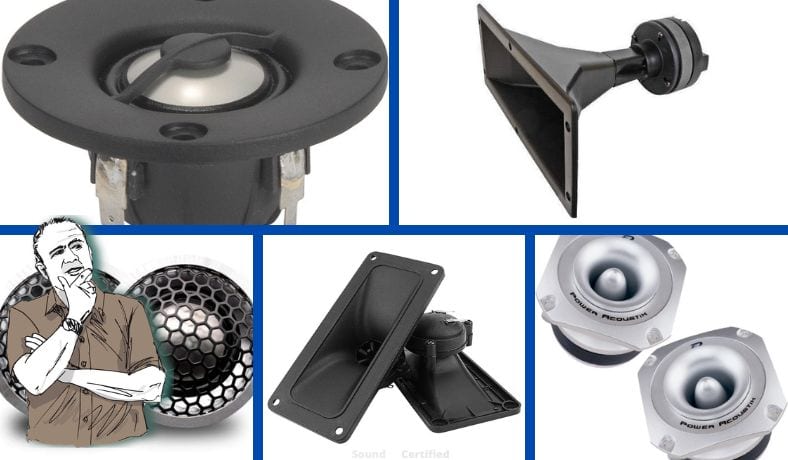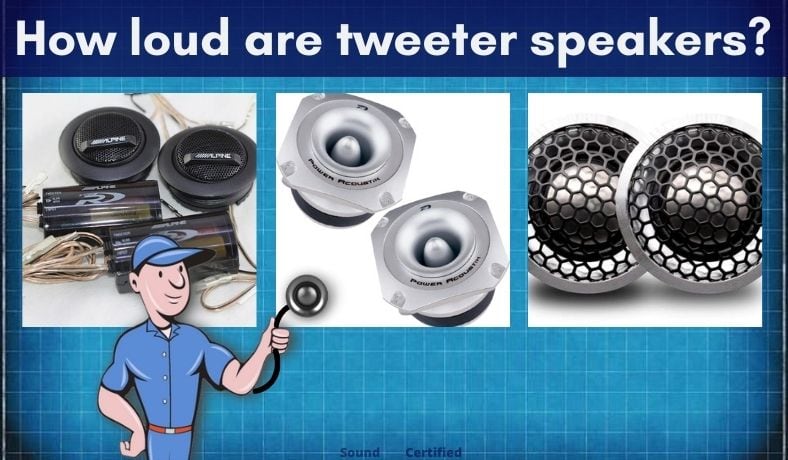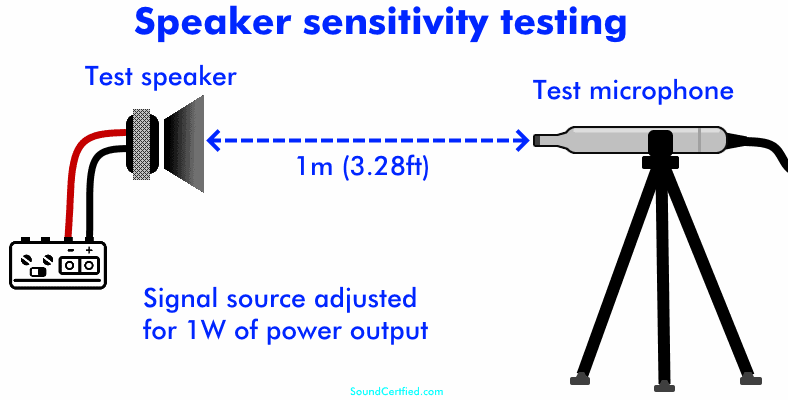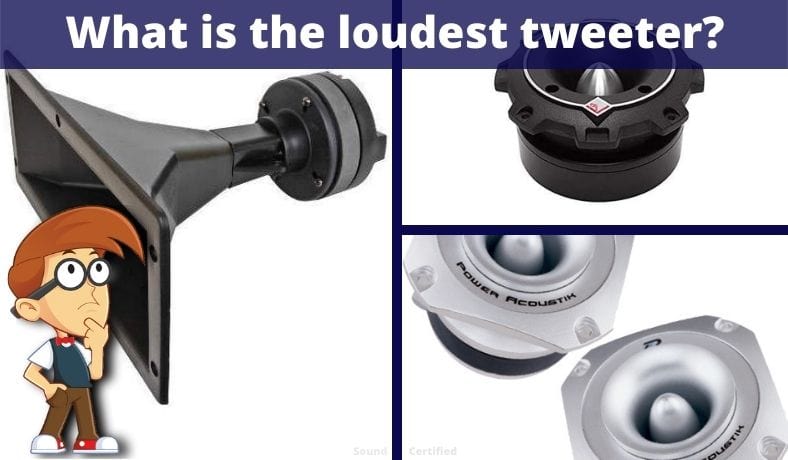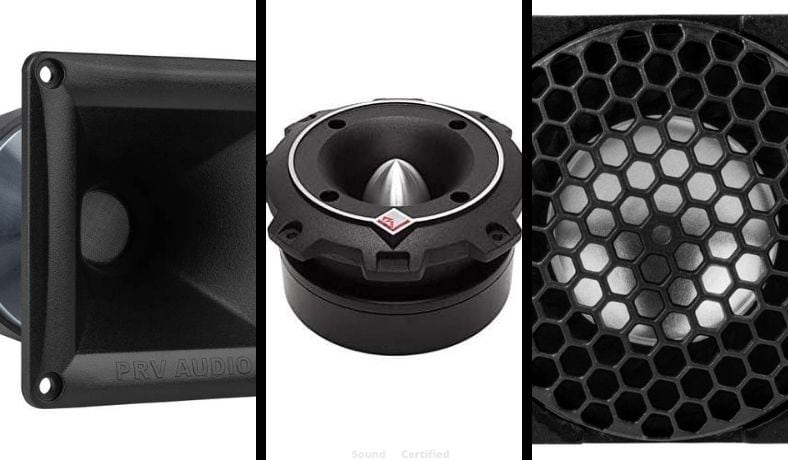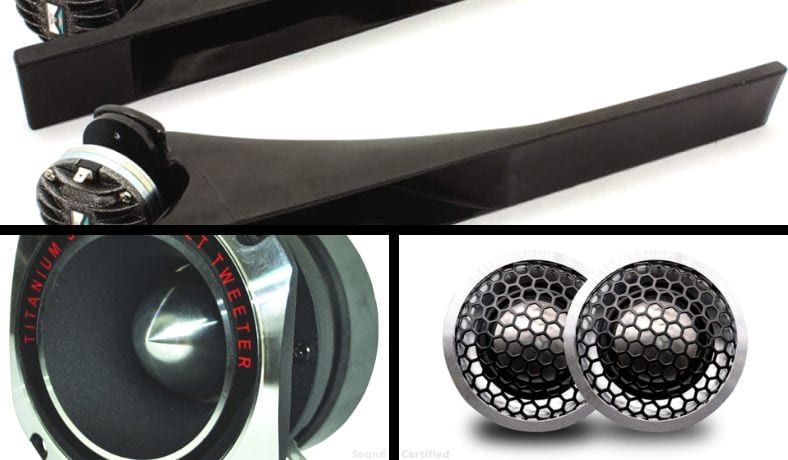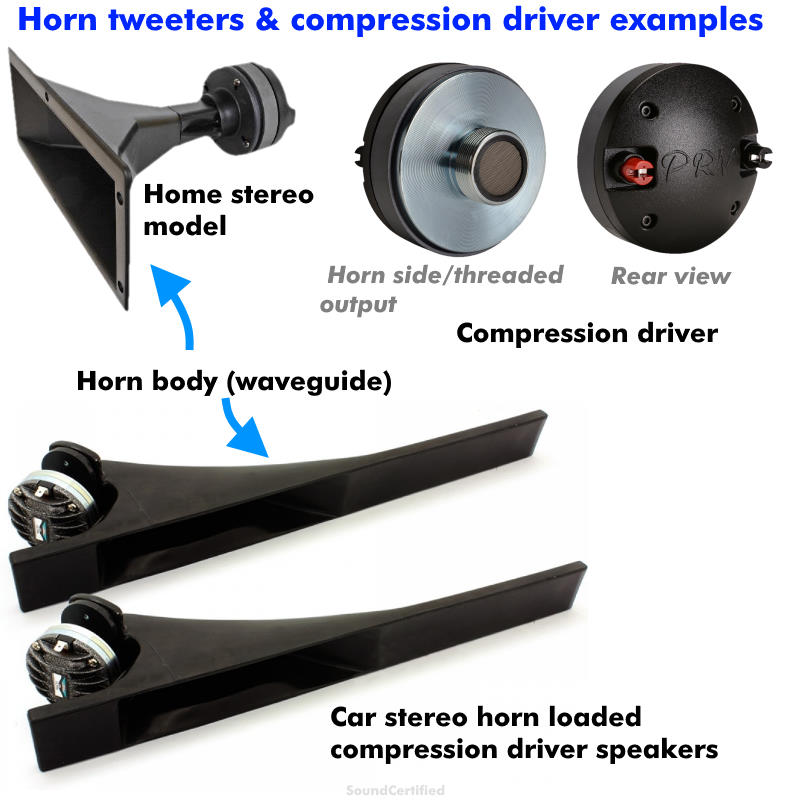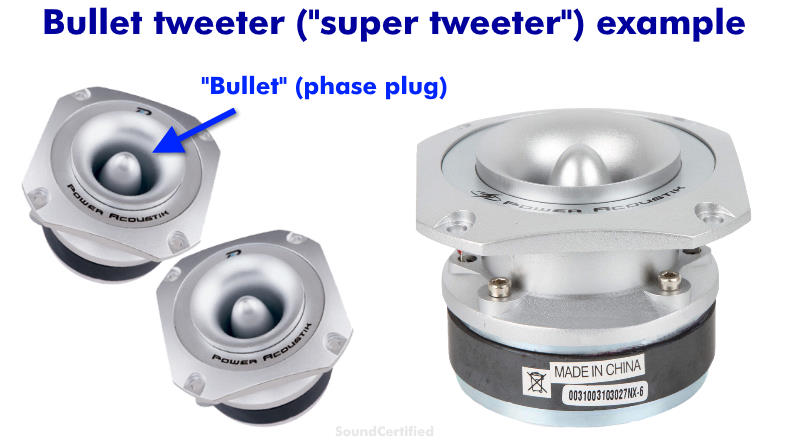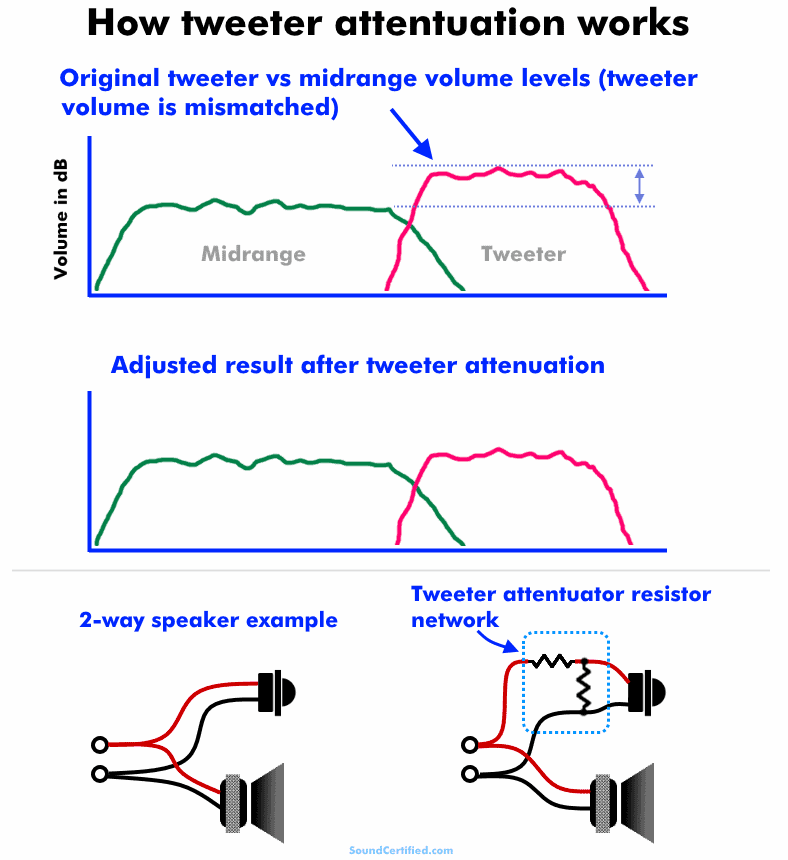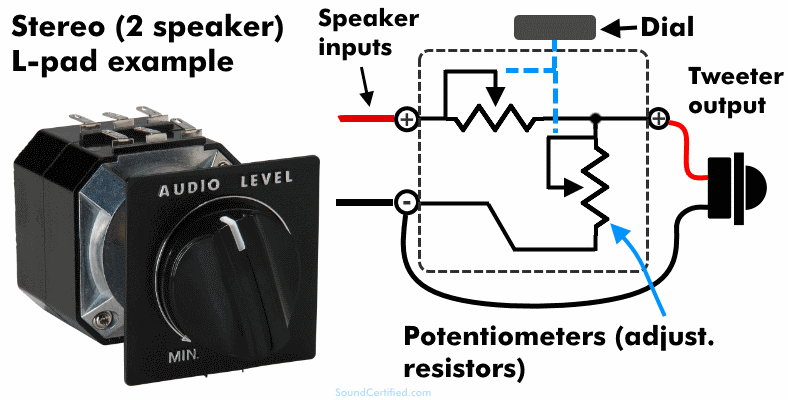It seems like there’s a ton of tweeter options out there for both home and car audio. But which types of tweeters are the loudest?
You’ll find out below as well as some other helpful info, too.
Contents
How loud are tweeter speakers?
Tweeter speakers have a loudness (sound pressure level) that range from about 98 decibels (dB) to 110dB at the reference point of 1 watt, 1 meter. They are typically louder at the same power level as a woofer speaker or midrange speaker.
The amount of volume produced by a tweeter for a given amount of power depends on its power to dB efficiency called the sensitivity. This depends on the particular performance level and tweeter design with certain types of tweeters being louder (higher sensitivity) than others.
What is tweeter sensitivity?
Speaker sensitivity is a measurement of the volume output level at a fixed sound frequency and (usually) with 1 watt of power delivered to the speaker at 1 meter (3.28 feet) from the test microphone.
A tweeter speaker’s sensitivity is a specification provided by the manufacturer that is useful for comparing them to and matching them with other speakers. It’s a measurement of the volume produced, in decibels, from a speaker at 1 meter (3.28 feet) from a test microphone for a test tone frequency.
A tweeter’s sensitivity rating is usually expressed as “89dB @ 1W/1M” or something similar. The measurement is made by supplying one watt of power at one meter distance. A 1kHz test tone is fairly standard for example.
Depending on the speaker, the sensitivity varies, with tweeters producing more sound for a given level of power. Subwoofers are inefficient because they need more power to drive the heavy cone and create sound.
The sensitivity of subwoofers tends to be around 87dB+, midrange speakers around 89dB, and dome tweeters at 93-102dB depending on the particular type as you’ll see. The loudness of tweeters makes a difference when using them with component speakers or 2-way speaker systems as you’ll see later.
Why do tweeters have high sensitivity?
Many tweeters have a high sensitivity and produce good volume in the higher frequency musical range because they don’t need a large cone and use a lighter dome material. This requires less power to produce sound.
High frequency sound uses a smaller sound wave (wavelength) and therefore a smaller tweeter size is possible. Low frequency sounds (bass notes) require a larger cone like those used in a woofer or midrange speaker.
Tweeter sound quality can also be very accurate and crisp with better quality models.
What is the loudest tweeter type?
Generally speaking the best tweeter types for volume are compression horn tweeters and bullet tweeters (super tweeter) types. Electrostatic tweeters and metal dome tweeter types are usually the second closest in volume output.
Here’s a handy chart comparing some tweeters and their typical sensitivity ranges:
Tweeter volume comparison table
| Tweeter Type | Typical Sensitivity (dB) |
|---|---|
| Compression horn | 105-110 |
| Bullet super tweeters | 104-108 |
| Metal dome | 90-94 |
| Ceramic | 90-92 |
| Ribbon, AMT | 91-93 |
| Electrostatic | 98-109 |
| Silk or soft dome | 88 – 92 |
| Piezo | 91-94 |
| Mylar / polycarbonate | 87-90 |
| Paper | 88-90 |
Loud tweeters for home audio system use
Some of the best tweeters for practical use in home stereo speaker systems are compression horn, bullet, and metal dome models.
Compression horn and bullet tweeter options are a great choice for high volume because:
- Many are a good compromise between performance and price.
- Good power handling (depends on the model).
- Good stereo imaging thanks to their sound dispersion.
- Work well in 2-way component speaker designs as they have a frequency response down to midrange frequencies in many cases.
Some are capable of producing ultra high frequencies outside the limits of human hearing.
A second choice, metal dome tweeters (such as aluminum tweeter or titanium tweeter types) are often available with slightly less volume output but can be very crisp and detailed. Hard dome tweeters are known for good detail.
Electrostatic tweeters can also have a high output (around the same as compression drivers) but are fairly rare and can be very expensive, too.
High volume tweeters for car audio use
Unfortunately, when it comes to car audio installation options you’re much more limited in choices especially if you’re replacing a factory tweeter installation. Factory-installed ones tend to have poor sound quality and are often a very cheap cone tweeter design.
Aftermarket car tweeters are usually one of a few types:
- Mylar or polycarbonate tweeters on coaxial speaker types
- Silk dome tweeters or cloth soft dome tweeter variations.
- Metal tweeter design (aluminum, titanium, or hybrid types)
- Piezo mini or piezo horn tweeters.
However, generally speaking the loudest car tweeter options are:
- Car horn loaded compression drivers (HLCD)
- Bullet tweeters
- Metal dome models
However, car audio HLCD types are very, very rare and expensive, too, so they’re not really much of an option. Car bullet tweeters are some of the loudest you can use (assuming you can install them) as they’re essentially another version of home stereo compression horn tweeters.
Note that when using tweeters with a high sensitivity rating alongside other car speakers they can sound very harsh due to too high of an output in the high frequency range. In that case, using an equalizer or tweeter attenuation can help a lot.
This is also true when using door speakers with dash or pillar mounted tweeters due to the difference in the amount of sound arriving at your ears.
What are compression horn tweeters and bullet super tweeters?
Compression horn tweeters and horn loaded drivers
A horn loaded compression driver has a horn tweeter design based on outputting sound waves which are guided outward with a plastic or resin material horn, sometimes called a waveguide. This allows them to create high-output sound with a controlled dispersion (output) for the best results and stereo imaging.
What is a compression driver in speakers?
Compression drivers use a magnet and voice coil design like conventional speakers but have a small diameter cylindrical opening instead of an exposed cone. They often have a threaded shaft designed to screw into a matching horn waveguide.
Most use a standard magnet & voice coil design with a dome made from anything such as Mylar, silk, metal, and more.
They’re often some of the best-performing speakers available and have been used in some of the most realistic and best-regarded home stereo speaker systems. Less expensive types are also found in an outdoor speaker system used for DJ music, music concerts, or public address (PA) systems where high volume is important.
The continuous power rating can be good, too: for example 50W, 75W, or 100 watts RMS.
Bullet tweeters
A bullet tweeter, sometimes also called a super tweeter is a variation of the compression horn tweeter but with two main differences:
- A significantly smaller horn (waveguide) for less installation space.
- A bullet shaped element (phase guide) attached to the center of the dome.
They’re available in both home speaker (8 ohm) or car speaker (4 ohm) versions and are available in many cases with good power handling.
What to do if your tweeters are too bright
Diagram showing how tweeter attenuation works to bring down the volume. An attenuation resistor network, sometimes called an L-pad, can be used to reduce the volume & power to a speaker.
Tweeter attenuation is a way to reduce harshness (“bright” tweeters) by decreasing the voltage & power to them. This is usually done with an adjustable L-pad or a resistor network with values chosen to match the expected load of a stereo, amplifier, or speaker crossover.
An L-pad makes it easy to reduce the volume from a tweeter as more or as little as is needed. They’re essentially a resistor network that uses variable resistors (potentiometers) to make this possible.
Normally they’re only available for 8 ohm impedance speakers, however, so they’re not really an option for car audio systems.
Why are my tweeters too bright?
Because of their high sensitivity, tweeters often have a higher output in the upper frequency range than the speakers they’re used with. When that happens there’s a mismatch you can hear that’s often described as being “too bright.”
Tweeters that are mismatched with a midrange speaker or woofer can sound uncomfortably harsh & the music sound unnatural – especially because our ears are more sensitive to that range of sound.
